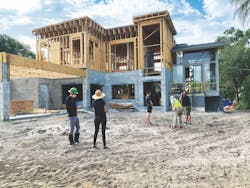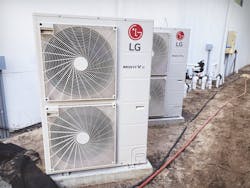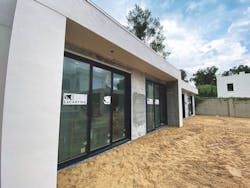Behind the Walls: The New American Remodel 2021
All remodelers are problem solvers— that’s the nature of the job. The best ones love big challenges, and a big remodel is a puzzle that poses challenges at different levels.
Multiple challenges were certainly the case with this year’s New American Remodel. Rob Smith of E2 Homes describes it as a “transformational” project that required creative solutions in design, performance, construction, and scheduling.Rob loves this type of project because the results are so satisfying. “After we complete a difficult job like this one I always enjoy walking through the new spaces, remembering what was there before we started, and feeling how amazingly better it is now,” says the Orlando remodeler.
What’s better in this home? Everything. It has been totally transformed for 21st-century lifestyles, with more interior space, lower energy use, and a more comfortable, healthier environment. While the path to those results wasn’t easy, it offers lessons to remodelers contemplating similar projects.
STRUCTURAL CHANGES
One of the major design challenges was how to make the home roomier. The old, 1970s structure consisted of small, discrete rooms. By contrast, the completed home has the open feel you would expect in a contemporary living space, including big expanses of exterior glazing—windows and sliding doors— that flood the home with natural light and visually connect the front and back yards.
Unfortunately, the original structure wasn’t up to the task of supporting an open floor plan, and it had been made even less so by water intrusion over the years that had developed rot in different areas. The roof looked close to a cave in and other parts of the house were sagging as well. That meant replacing much of the original framing.
As we wrote about in our January TNAR feature, part of making the house feel bigger was creating more headroom. On the main level the new framing plan made it possible for the design and construction team to create high ceilings in some rooms. The high-ceiling rooms had open connections to adjacent rooms that, because of the floor above, were stuck with low ceilings. Those connections, when combined with the glazing, ensured that even the low-ceiling areas didn’t feel cramped.
Unfortunately, in one room, the ground level entry, it was not possible to raise the ceiling or add glass. The only way to get more headroom there was to lower the concrete floor, which the team unanimously agreed was an effort worth the cost. The E2 crew jackhammered and removed the existing slab in the entry area, excavatedLowering the entry slab had two advantages besides adding a foot of headroom. One was that it eliminated the step from the entry to the driveway at the front of the house. Another was that E2 was able to install new plumbing for a floor drain and a hand-washing sink.
PERFORMANCE MODEL
While the remodeled home’s aesthetic accomplishments are impressive, imprOne project requirement was that the finished home meet Net Zero Energy standards, which means the solar panels have to generate more energy on an annual basis than the home uses. Numerically, a Net Zero home is defined by a score of zero or less from the Home Energy Rating System, or HERS.
Net Zero is a commitment to sustainability. Adding solar to an energy hog will not get you there.
A HERS index score of 100 denotes a “base” home—one that meets all the requirements of the current energy code. A score of zero means the home’s energy loads equal the solar panels’ output, while a negative score means the panels produce more energy than needed. The New American Remodel earned a HERS score of -11.
Net Zero is a commitment to sustainability. Adding solar to an energy hog will not get you there. Builders and remodelers committed to achieving Net Zero seek to lower the HERS score as much as possible before sizing the solar system. This approach also makes financial sense: solar is expensive, so you will get a higher rate of return from your dollars with insulation, windows, and air sealing. The New American Remodel achieved a pre-solar HERS score of 44, a sizable improvement over the Florida energy code.
You could theoreticaBack in the 1990s, glass accounted for 8 to 10% of the average home’s wall area; today, 18 to 25% is more typical. With 1,631 square feet of glazing in 5,113 square feet of wall area, The New American Remodel’s walls are more than one-third glass. While that is an aesthetic boon, it also makes achieving Net Zero a bit more challenging.
ACHIEVING A TOP HERS SCORE
The key to balancing performance and looks is soft ware. Drew Smith of Two Trails Inc., sustainability consultant for the project, entered the home’s details—floor plans, window and door specs, insulation, exterior finishes, roof shape, mechanical system— into an energy modeling program called Energy Gauge. (He says it’s similar to the more widely-used REM Rate.) The software let him optimize performance by modeling what-ifs using different product choices. “For instance, we can predict how the HERS index will be affected if we change the attic insulation,” says Drew.Total modeling time was between 50 and 60 hours, but this was a large, complicated structure. Smaller, simpler jobs can be modeled more quickly.
Energy modeling is more widely used by new-home builders than remodelers. In a big remodel though, it’s a great way to ensure not just energy efficiency but health and durability as well. It’s because deep energy retrofits like this one include more efficient glazing, thicker insulation, and better air sealing, which work together to drastically reduce heating and cooling loads. Modeling software helps the remodeler ensure that the HVAC equipment and ductwork are properly sized for those new loads.
The main worry in a humid climate like Florida is that the old heat pump will end up oversized. That means it will short cycle, and won’t do a good job removing moisture from the home.
To prevent humidity problems, Drew advises modeling every big project, even if it’s not energy-focused, then replacing the heat pump and ductwork if needed. “I see a lot of major remodels where the old equipment doesn’t get replaced,” he says. “Mold eventually starts to grow and you end up with a sick building and sick homeowners.”
He also advises modeling homes before work begins to establish a baseline HERS Index score. “On this home we got a pre-construction score of 147,” he says. “That’s 47% worse than a base home. It was the worst performing home we had ever seen.”
Although few remodelers do pre-project modeling, it can be a real motivator. “A preconstruction HERS score helps get everyone focused on how to lower it and how to make the house more efficient,” he says. “And at the end of the project, the new score will help you quantify the value you added to the home.”
DETAILS AND EQUIPMENT
That value of course is created by the products and construction details used. Products that impact home performance include windows, insulation, air sealing and mechanical equipment.
Again, the key is to use the modeling software to oDifferent types of glass optimize for different conditions. This home uses Jeld-Wen and LaCantina doors and windows with U-Factors of 0.30. Conductive heat transfer isn’t a big issue in Florida, so while 0.30 would be low in Chicago, it’s fine for Orlando. A big issue in this climate is solar heat gain, and the glazing’s SHGC of 0.20 is considered very good.
Similarly, convective heat transfer through opaque wall surfaces isn’t a big worry, so the home only needed wall insulation values of R14 and R15. Roof assemblies are a different matter. The intense sun is why so many homes in Florida have white roofs. The New American Home has an R21 roof system.
Another important issue in Florida, as in all climates, is air leakage. A combination of Demilec spray foam insulation and Aerobarrier envelope sealing technology lowered air leakage, as measured by a blower door test, to 2.47 air changes per hour at a standard 50 Pascals (ACH50).
Heating and cooling is provided by a super-efficient, SEER 28 Variable Refrigerant Flow, or VRF Heat Pump from LG Home Comfort Systems. The main home is served by two five-ton outdoor condensers, each of which supplies two air handlers located in the mechanical rooms. The indoor units are individually zoned. “This is one of the most energy-efficient systems available in the current marketplace,” says Drew. “It’s hard to beat VRF.”LG says this is also the first five-ton residential unit that can be operated on a 40 amp, single-phase power supply. That’s because its motors run on Direct Current, which is supplied by inverter technology that changes AC house current to DC.
How does that reduce power needs? The answer is that with an AC motor, the power supply has to be sized to provide a power spike on startup. That’s not necessary with a DC motor, so the power needs are lower. The lower power requirements also mean the home can get by with a smaller backup generator.
To help ensure indoor air quality, the home has an Aprilaire whole-house dehumidifier. This is something a lot of homeowners don’t think they need in Florida because they figure the heat pump will dry the air. That’s comfortable when it’s 80 or 90 degrees outside, but when temperatures drop to the 70s, people will end up walking around the house in sweaters.
A whole-house dehumidifier can be integrated into the ductwork to keep the home dry but not cold during these times.







